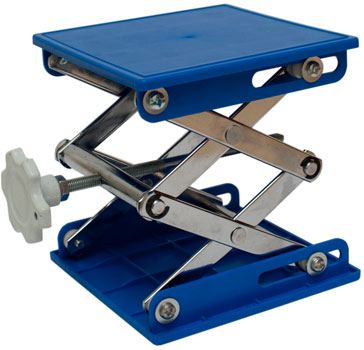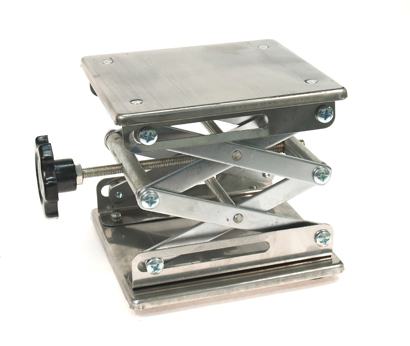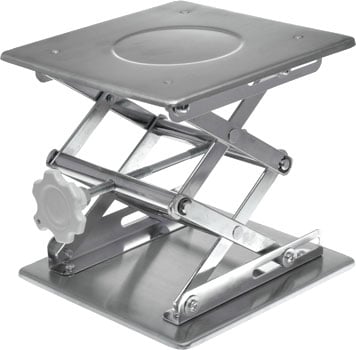A Quick Guide to Laboratory Jacks
December 8, 2022

Complete your chemistry workbench setup with laboratory jacks.
Chemical processes need a stable working base to place objects at a certain height. On top of a strong footing, adjustment and support are also crucial.
Considered among the ‘essential’ lab equipment, laboratory jacks cater to this need. This quick guide shows you the proper use of this elevation tool to level up your next experiment!
Laboratory Jacks
It is never a good idea to put undue stress on glass joints. This is where laboratory jacks come into the picture. This apparatus, however, is often overlooked as part of a lab that makes heavy use of glassware. It is a must-have, providing that much-needed support.
Designed for convenient high-load capacities, laboratory jacks do the heavy lifting. They provide easy adjustment with a simple twist of a knob, ideal for apparatuses like flasks and beakers, to name a few.
Depending on the material, they can be used in different lab situations. The uses are typically in chemical, biomedical, pharmaceutical and university laboratories.
Common materials include mild steel, aluminium or stainless steel. Mild steel and aluminium are ideal for basic laboratory work. Stainless steel, in contrast, is more suitable for heavy-duty applications.
A set may include a removable platform that attaches to the lab jack using the support rod.
The Working Principle
A lab jack consists of metal pieces connected together in a scissor-like shape. This is where laboratory jacks got their “scissor jack” nickname.
The metal piece acts as an adjustable lift using the scissors mechanism. This feature allows for height adjustment around 5cm to 20cm and also can withstand a range of weights. The knob at the side adjusts the height level of the top platform.
A lab jack works mechanically with a central screw. This screw connects to the central piece between two layers of crossing metal pieces. It also supports the metal pieces in withstanding the oppressing weight.
Turning the screw increases and decreases the angle between the metal pieces. This results in the extension and contraction of the platform height. Most lab jacks are manually operated, but others are motorised and powered by stepper motors.
Using a Lab Jack
When using a lab jack, position it on a flat and stable surface. Place the apparatus right in the center of the platform for even loading.
Do not overload, and check the weight limitations provided by the manufacturer. Standard lab jacks have a weight capacity of 10 to 30 kg and can go up to 100 kg.
Avoid changing the height level when you already have an object on the platform. If you must, hold the apparatus while you turn the knob to avoid spillage. Clean the lab jack with a soft dry cloth after every use to keep it debris-free.
Benefits of Using Laboratory Jacks
A lab jack can be placed underneath glassware. The height is adjustable with the easy turn of a knob. If you think about it, how it works is very simple. Even so, it comes with fantastic benefits, including:
Achieving smooth, precise adjustments
The knob makes fine height adjustments a breeze. Most knobs are smooth to turn and offer precise control.
To keep your glassware more firmly in place during your runs, use a lab pad. It protects the glass from breaking and provides a better base between the metal.
Available in a variety of sizes and finishes
Laboratory jacks come in a variety of sizes and finishes. Each is designed for different applications.
Make sure to use the right-sized jack for what it will be holding. When in doubt, it is best to opt for a larger unit over a small one to be safe.
Other advantages:
- Easy to clean and reliable
- Lightweight, small form-factor
- Stabilises sensitive objects in an effective manner
- Suitable for benchtop glassware and other lab apparatuses
- Offers secured elevation and support
Get Your Laboratory Jacks Here!
Check out our range of scissor jack products from our leading supplier. Available in metal or plastic plates.

Laboratory Scissor Jack Economy
Product code: LH1122-150
This laboratory jack features ABS plastic plates with a chrome-plated scissor lift. Suitable for elevating lab equipment to the desired height. Adjustable up to 65mm to 240mm and very convenient to use.

Laboratory Scissor Jack – Metal 150mm
Product code: LH1120-150
Features metal plates and a scissor lift with an adjustable height of 80mm to 270mm. 150mm x 150mm in size.

Laboratory Scissor Jack – Metal 200mm
Product code: LH1120-200
Made of high-quality stainless steel. The lift has excellent stability and is corrosion resistant. Adjustable up to 80mm to 30mm and very convenient to use.
The Bottom Line
Laboratory jacks offer a stable surface at a specific height for glassware. Also ideal for a water bath, stirrer, and other sensitive apparatus. A range of sizes and weight loads to suit most applications.
© Electrotech Brands Pty Ltd 2022


Write a Comment
You must be logged in to post a comment.